Vegetarian Ideal
Nothing will benefit human health and increase the chances for survival of life on Earth as much as the evolution to a vegetarian diet.
- Albert Einstein
Thursday, May 21, 2015
Sunday, May 17, 2015
Church in Borgloon, Belgium.
This Church Might Not Look Like Anything Special, Until You See It From Different Angles
April 27, 2015
The architect group, Gijs Van Vaerenbergh, built this church in Borgloon, Belgium. It doesn't look like anything special... from certain angles.
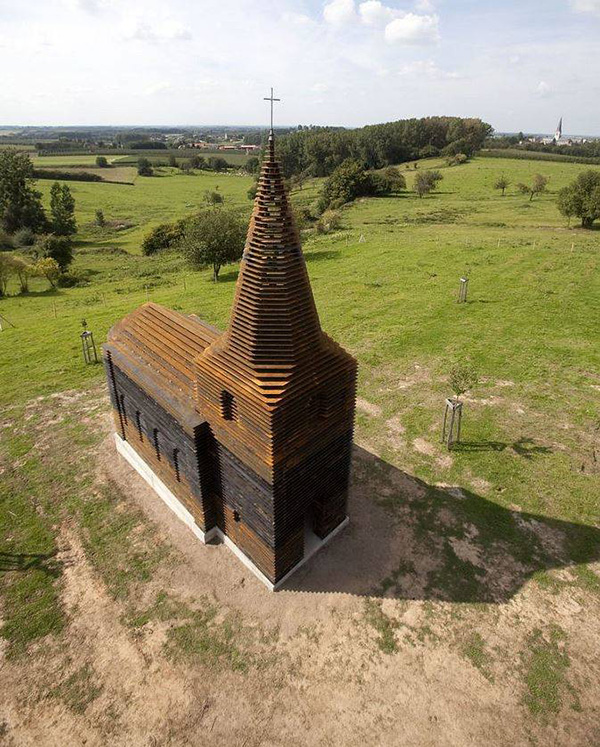
imgur
From other angles, the structure reveals itself to be something else entirely
.
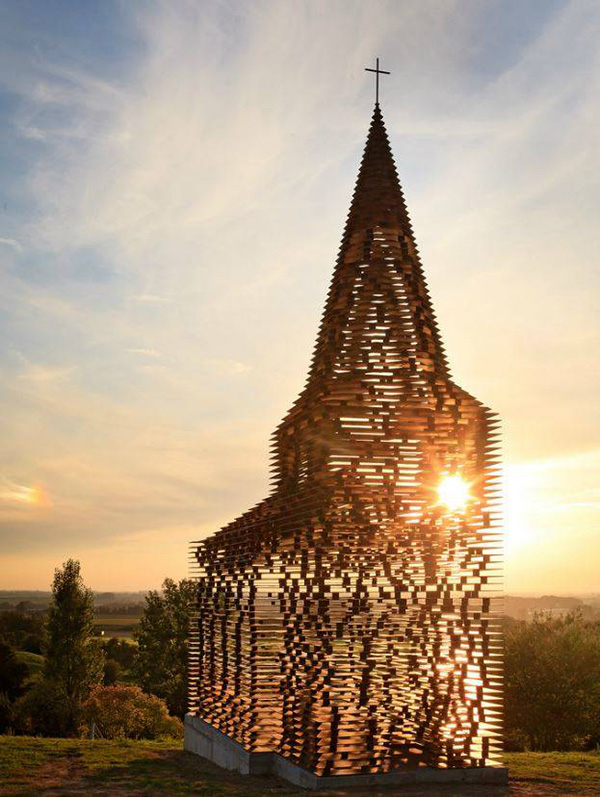
imgur
A building that's almost entirely see through.
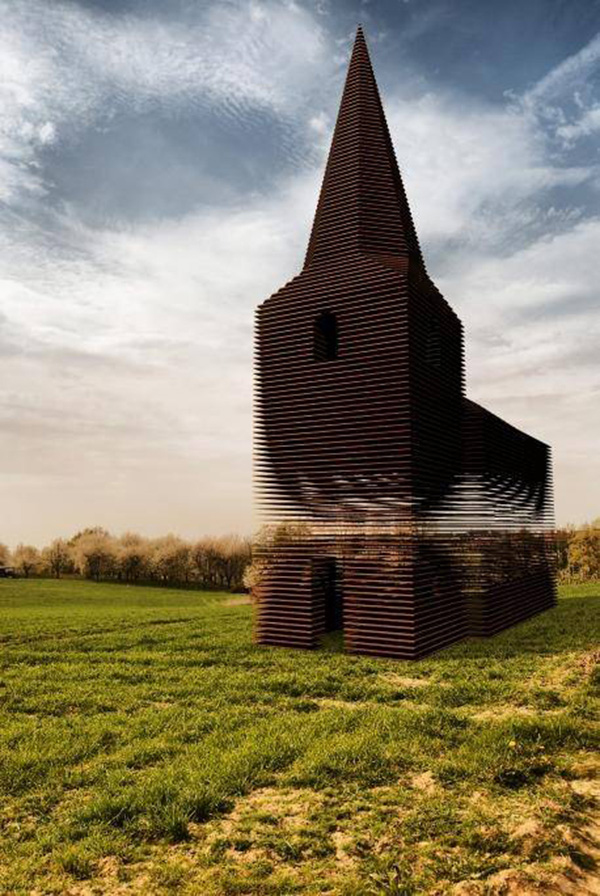
imgur
It consists of 100 layers of stacked steel, that are equidistantly staggered in a way that illusively change in appearance based on where the viewer is standing.
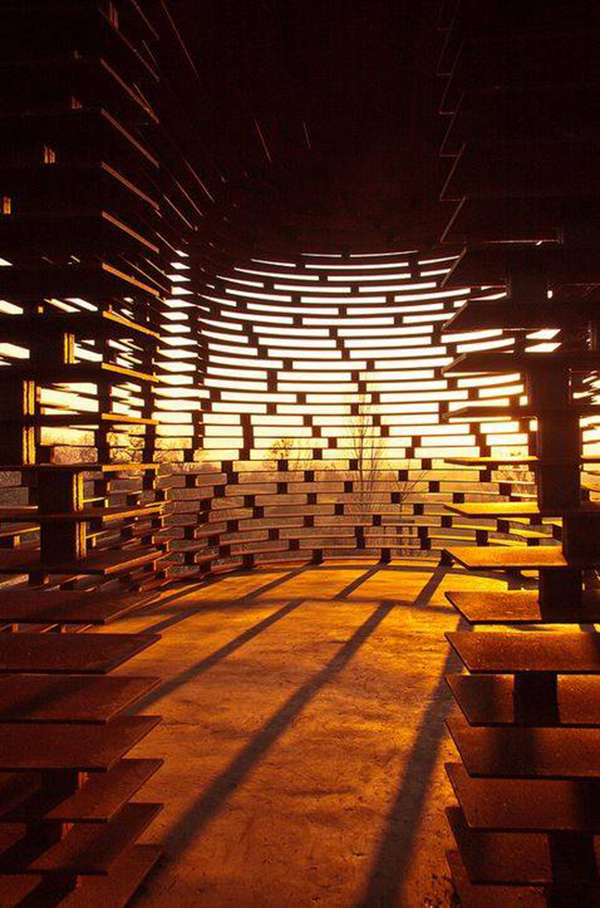
imgur
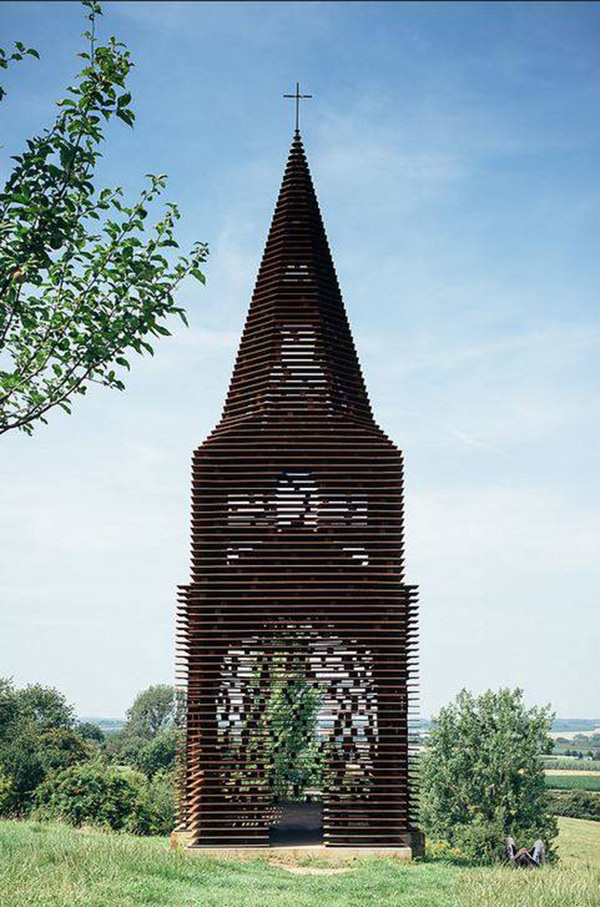
imgur
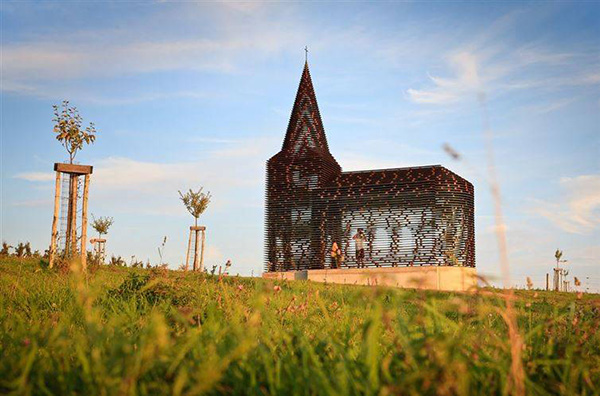
imgur

imgur
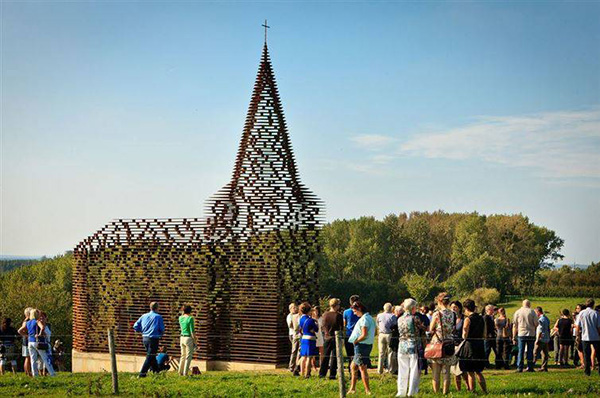
imgur
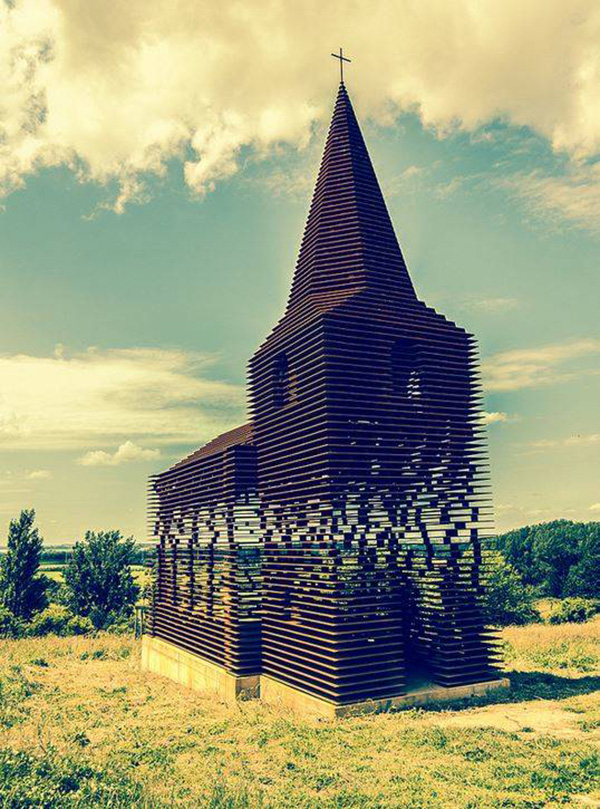
imgur
Credit: sokohilton.
Read more at http://www.sunnyskyz.com/blog.php?blogid=808%2FThis-Church-Might-Not-Look-Like-Anything-Special-Until-You-See-It-From-Different-Angles#uiEHLSGDZFh38Vz7.99
Comment:
Thank you for forwarding the link! I found the church very fascinating - both from a structural engineering standpoint, and from an architectural standpoint. Structurally, it’s a clever use of steel to achieve the desired effects of transparency and mystery. With the sculpture placed in the setting of a picturesque countryside, and the idea that people are to see through the church and see the beauty of nature beyond it, makes me think that the architects were making several important statements. For those who believe in such things, God is indeed transparent and mysterious, and if people see the sculpture strictly and entirely only in this way, I believe they are missing a broader interpretation of the work. The sculpture of the church as a symbol of God is a recognizable form, but with it being placed in this particular setting and built in this particular way, its function has been completely changed and reshaped to serve a counter purpose. To me, it is saying, look past the traditional church, with its established and predictable structures, and see nature and the world as it is beyond the opaque walls of the church. It is out there, not inside these four walls, but out there – that is where you will find your God. Inside the sculpture there is no alter or pews or chairs for the traditional gathering of people. It provides little protection from the elements, especially from the wind and cold. It is saying this structure cannot protect you; it is not meant for the traditional gathering of people within its walls. It is meant for you to question, how does it stand? Why did man build it in this way? For what purpose was it built?
If the entire history of the Earth were contained in one calendar year such that the beginning of our planet started at a fraction of a second past midnight onJanuary 1st, and we are now (365 days later) at 11:59:59 p.m. on December 31st, the entire history of mankind began at approximately 11:54 p.m.. Within this 6 minutes of time, the entire history of mankind (including prehistoric man) existed up to this present moment. According to this time scale, the first of the Egyptian Pyramids were built about 30 seconds ago, and Jesus Christ (the man for whom the church was built) lived and died only about 14 seconds ago.
Compared to all these things that are very difficult to understand, and inherently lead to questions with no easy answers, the structural engineering challenges of building the church are easy. The steel plates that were used are very strong and withstand the forces between the support points quite easily. Notice they used wide steel plates – other materials without the strength of steel would not have worked so effectively. The wide steel plates served two purposes - they provided the aesthetic quality of substance in the horizontal planes of the structure, and they provided the necessary stiffness with nominal depth requirements. By distributing the structure’s loads somewhat evenly throughout the walls (instead of at concentrated column locations as in traditional buildings), the forces at each of the small blocks between the plates were kept to a minimum. The lateral wind load effects were also minimized because the wind is able to blow through the walls, and the total weight of the steel structure itself keeps everything stable. It’s a very clever design structurally, and it’s very effective architecturally.
I definitely know this response was far more than you expected, but the link you sent really made me think about a few things. Good art, as you know so well, has a tendency to that.
http://www.sunnyskyz.com/blog.php?blogid=808%2FThis-Church-Might-Not-Look-Like-Anything-Special-Until-You-See-It-From-Different-Angles#ValvvFplYVRsGR0S.01

If the entire history of the Earth were contained in one calendar year such that the beginning of our planet started at a fraction of a second past midnight onJanuary 1st, and we are now (365 days later) at 11:59:59 p.m. on December 31st, the entire history of mankind began at approximately 11:54 p.m.. Within this 6 minutes of time, the entire history of mankind (including prehistoric man) existed up to this present moment. According to this time scale, the first of the Egyptian Pyramids were built about 30 seconds ago, and Jesus Christ (the man for whom the church was built) lived and died only about 14 seconds ago.
Compared to all these things that are very difficult to understand, and inherently lead to questions with no easy answers, the structural engineering challenges of building the church are easy. The steel plates that were used are very strong and withstand the forces between the support points quite easily. Notice they used wide steel plates – other materials without the strength of steel would not have worked so effectively. The wide steel plates served two purposes - they provided the aesthetic quality of substance in the horizontal planes of the structure, and they provided the necessary stiffness with nominal depth requirements. By distributing the structure’s loads somewhat evenly throughout the walls (instead of at concentrated column locations as in traditional buildings), the forces at each of the small blocks between the plates were kept to a minimum. The lateral wind load effects were also minimized because the wind is able to blow through the walls, and the total weight of the steel structure itself keeps everything stable. It’s a very clever design structurally, and it’s very effective architecturally.
I definitely know this response was far more than you expected, but the link you sent really made me think about a few things. Good art, as you know so well, has a tendency to that.
http://www.sunnyskyz.com/blog.php?blogid=808%2FThis-Church-Might-Not-Look-Like-Anything-Special-Until-You-See-It-From-Different-Angles#ValvvFplYVRsGR0S.01

Tuesday, May 12, 2015
Musical Genius: Rev. Gary Davis
Today's selection -- from Say No to the Devil by Ian Zack. Though Ledbelly,
Muddy Waters, Robert Johnson and others became more renowned, many consider early twentieth century bluesman Rev. Gary Davis (1896-1972) to be the most talented of them all. Bob Dylan called him "one of the wizards of modern music," and he was revered by such luminaries as the Grateful Dead's Bob Weir and the Jefferson Airplane's Jorma Kaukonen. Blinded shortly after birth by negligent medical care and emotionally abandoned by his mother, Davis's music had a power beyond most of his contemporaries readily evident in such songs as "Death Don't Have No Mercy in this Land" and "You've Got to Go Down":
"Gary Davis's mother, the former Evelina Martin, was seventeen when she gave birth, and she would go on to have a total of eight children, most likely by multiple fathers. But with proper medical care for blacks practically nonexistent, six of her children died as infants; only Gary and a younger brother -- probably a half-brother, named Buddy Pinson -- survived, and Buddy would die in 1930 at age twenty-five, stabbed to death by a girlfriend with a butcher's knife. That would leave Gary as the sole survivor of Evelina Davis's large brood.
"The event that would define Davis's life -- the loss of his sight -- occurred soon after birth. 'I'd taken sore eyes when I was three weeks old,' he recalled in one version of the story. 'They [took] me to a doctor and the doctor put some alum and sweet milk in my eyes and they caused ulcers in my eyes. That's what caused me to go blind.' In his later application to attend a school for the blind, Davis's mother would tell a similar story, blaming his blindness on 'medicines of doctor who made a mistake.'
 "A doctor who examined him as an adult would conclude that Davis had suffered both infant glaucoma and ulceration of the cornea, a condition that can result from neonatal conjunctivitis contracted from a mother with gonorrhea and also can afflict children with a severe Vitamin A deficiency. As to what led to Davis's blindness, a family friend named Tiny Robinson gave a different explanation: she said Davis's mother blinded him by trying to treat his eye infection with lye soap, an old folk remedy. Davis's second wife, Annie, corroborated the story about the doctor as Davis himself told it. Both accounts seem plausible, but the common denominator was the absence of even rudimentary medical care. Davis said the doctor told his family that he 'might overcome it' as he aged, but he never regained his sight. ...
"A doctor who examined him as an adult would conclude that Davis had suffered both infant glaucoma and ulceration of the cornea, a condition that can result from neonatal conjunctivitis contracted from a mother with gonorrhea and also can afflict children with a severe Vitamin A deficiency. As to what led to Davis's blindness, a family friend named Tiny Robinson gave a different explanation: she said Davis's mother blinded him by trying to treat his eye infection with lye soap, an old folk remedy. Davis's second wife, Annie, corroborated the story about the doctor as Davis himself told it. Both accounts seem plausible, but the common denominator was the absence of even rudimentary medical care. Davis said the doctor told his family that he 'might overcome it' as he aged, but he never regained his sight. ...
"Davis's parents weren't well suited to raising children, and Davis's maternal grandmother, whose maiden name was Annie Spencer, quickly assumed responsibility for young sightless Gary. Davis's mother 'was once upon a time a rough woman' -- a southern euphemism for being sexually loose -- who was always 'twistin' about from one place to another,' Davis remembered, and 'didn't care to be bothered with no children.' His father was 'in trouble all the time.' John Davis eventually left South Carolina and was shot to death around 1906 by the sheriff in Birmingham, Alabama, apparently after slitting a lover's throat and telling the authorities, 'Come and get me.'
"Evelina Davis not only gave up primary responsibility for raising her son to her mother -- she outright rejected Gary emotionally, although she remained in his life. The abandonment had a profound effect on him. As Davis later recalled:
"It's surely no coincidence that the themes of death, abandonment, the lost child in the wilderness, and a reunion with his mother ran through Davis's gospel message and music. Indeed, gospel as an art form grew out of the misery and deprivation of the southern black experience, and those themes are common in the music as a whole. In Davis's case, it's easy to see why. Perhaps his most famous song, 'Death Don't Have No Mercy,' though based on traditional spirituals, has a strong autobiographical element for the only surviving child of eight, with its signature lament, 'death don't have no mercy in this land.'
"Davis would often sing about seeing his mother in heaven, when, presumably, all would be forgiven under God's grace. But his anger would also remain palpable. In 'Lord, I Wish I Could See,' he would address his mother's rejection in searingly poetic detail, singing: 'Nobody cares for me, because I'm away in the dark and I cannot see.' "
"Gary Davis's mother, the former Evelina Martin, was seventeen when she gave birth, and she would go on to have a total of eight children, most likely by multiple fathers. But with proper medical care for blacks practically nonexistent, six of her children died as infants; only Gary and a younger brother -- probably a half-brother, named Buddy Pinson -- survived, and Buddy would die in 1930 at age twenty-five, stabbed to death by a girlfriend with a butcher's knife. That would leave Gary as the sole survivor of Evelina Davis's large brood.
"The event that would define Davis's life -- the loss of his sight -- occurred soon after birth. 'I'd taken sore eyes when I was three weeks old,' he recalled in one version of the story. 'They [took] me to a doctor and the doctor put some alum and sweet milk in my eyes and they caused ulcers in my eyes. That's what caused me to go blind.' In his later application to attend a school for the blind, Davis's mother would tell a similar story, blaming his blindness on 'medicines of doctor who made a mistake.'
 "A doctor who examined him as an adult would conclude that Davis had suffered both infant glaucoma and ulceration of the cornea, a condition that can result from neonatal conjunctivitis contracted from a mother with gonorrhea and also can afflict children with a severe Vitamin A deficiency. As to what led to Davis's blindness, a family friend named Tiny Robinson gave a different explanation: she said Davis's mother blinded him by trying to treat his eye infection with lye soap, an old folk remedy. Davis's second wife, Annie, corroborated the story about the doctor as Davis himself told it. Both accounts seem plausible, but the common denominator was the absence of even rudimentary medical care. Davis said the doctor told his family that he 'might overcome it' as he aged, but he never regained his sight. ...
"A doctor who examined him as an adult would conclude that Davis had suffered both infant glaucoma and ulceration of the cornea, a condition that can result from neonatal conjunctivitis contracted from a mother with gonorrhea and also can afflict children with a severe Vitamin A deficiency. As to what led to Davis's blindness, a family friend named Tiny Robinson gave a different explanation: she said Davis's mother blinded him by trying to treat his eye infection with lye soap, an old folk remedy. Davis's second wife, Annie, corroborated the story about the doctor as Davis himself told it. Both accounts seem plausible, but the common denominator was the absence of even rudimentary medical care. Davis said the doctor told his family that he 'might overcome it' as he aged, but he never regained his sight. ..."Davis's parents weren't well suited to raising children, and Davis's maternal grandmother, whose maiden name was Annie Spencer, quickly assumed responsibility for young sightless Gary. Davis's mother 'was once upon a time a rough woman' -- a southern euphemism for being sexually loose -- who was always 'twistin' about from one place to another,' Davis remembered, and 'didn't care to be bothered with no children.' His father was 'in trouble all the time.' John Davis eventually left South Carolina and was shot to death around 1906 by the sheriff in Birmingham, Alabama, apparently after slitting a lover's throat and telling the authorities, 'Come and get me.'
"Evelina Davis not only gave up primary responsibility for raising her son to her mother -- she outright rejected Gary emotionally, although she remained in his life. The abandonment had a profound effect on him. As Davis later recalled:
I felt horrible about it 'cause I felt like I was throwed away. In fact, my mother never had cared as much about me as she did my younger brother .... He was her heart .... Because of the way she talkin' to me, she'd wish that I were dead. She tell me that a heap of times.
"It's surely no coincidence that the themes of death, abandonment, the lost child in the wilderness, and a reunion with his mother ran through Davis's gospel message and music. Indeed, gospel as an art form grew out of the misery and deprivation of the southern black experience, and those themes are common in the music as a whole. In Davis's case, it's easy to see why. Perhaps his most famous song, 'Death Don't Have No Mercy,' though based on traditional spirituals, has a strong autobiographical element for the only surviving child of eight, with its signature lament, 'death don't have no mercy in this land.'
"Davis would often sing about seeing his mother in heaven, when, presumably, all would be forgiven under God's grace. But his anger would also remain palpable. In 'Lord, I Wish I Could See,' he would address his mother's rejection in searingly poetic detail, singing: 'Nobody cares for me, because I'm away in the dark and I cannot see.' "

Say No to the Devil: The Life and Musical Genius of Rev. Gary Davis
Author: Ian Zack
Publisher: University Of Chicago Press
Copyright 2015 by Ian Zack
8-10
Source: http://www.delanceyplace.com/
Subscribe to:
Posts (Atom)
